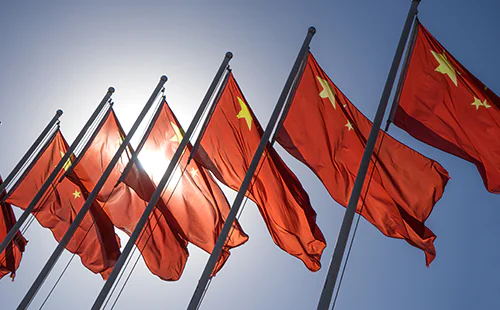The author of In Line Behind a Billion People: How Scarcity Will Define China’s Ascent reflects on the scenarios put forward in the book and how they have come to fruition over the last 10 years
By Damien Ma, Managing Director of the MacroPolo think tank at the Paulson Institute
In 2012, my co-author Bill Adams and I set out with an idea for a manuscript that aimed to provide an enduring mental model for how to think about the Chinese political economy. That mental model was centered on viewing China’s behaviors through the interplay of scarcity and competition. This was, we thought, a way to crystallize how China really worked in reality rather than through theoretical abstractions.
The timing was perhaps somewhat serendipitous as China had just gotten a new leader in Xi Jinping. And when In Line Behind a Billion People: How Scarcity Will Define China’s Ascent was published in 2013, we proposed that various manifestations of scarcity would be the central challenge for the new administration for the next decade.
Nearly a decade since the book’s publication, China has reached roughly 70% of US GDP, is the world’s largest trader, and by most metrics is considered a global powerhouse. Yet even as it is on the cusp of escaping the middle-income trap, it has yet to shake off the scarcity trap.
One needs to look no further than the key decision made at the 19th Communist Party Congress in 2017, in which a new “principal contradiction” was rolled out. What that means in reality is that if China were to become the world’s biggest economy by 2035, which is Beijing’s stated goal, it would be accompanied by having the world’s largest middle class.
That dramatic shift, then, will require resolving the new “contradiction” of meeting middle class expectations, including housing, education and social welfare that constitute what we termed “social scarcities.” Numerous neologisms, the latest incarnation being “common prosperity,” have been proffered by the Xi administration to capture policies that are meant to address these scarcities.
A key litmus test of any mental model is whether it has some utility in getting a few of the big things right. And in 2021, it seems clearer than ever that the Chinese leadership has reached a consensus that what defines China’s continued development is no longer growth, but addressing the constraints posed by economic, social and ideological scarcities.
It is the only way to transform China’s economy and to set it on course to becoming the superpower it aspires to be.
Economic scarcity
One of the most consequential economic scarcities highlighted in our book was labor. There is now a wide consensus within China that over the past decade the country reached its “Lewis turning point”—the rural-to-urban labor force transition has peaked. Huang Qifan, former mayor of Chongqing and well-known technocrat, admitted recently that urbanization will not contribute much to China’s future growth.
An aging population and an outdated fertility policy mean more workers are aging out of the labor force than are being replaced. Or to the extent that they’re being replaced, it’s from the excess of college graduates over the last decade, many of whom are making only marginally more than migrant workers. China’s college bubble may have left graduates without debt, but also without prospects.
Although China’s total labor force is still around 900 million strong, its structure no longer supports an export- and investment-intensive growth model, not least because there is significant upward pressure on labor costs.
Dual circulation, then, is Beijing’s espoused strategy to initiate the necessary pivot to developing the domestic market now that exports and urbanization are taking a backseat in terms of growth. In other words, Beijing is hoping to actualize what has been previously referred to as “rebalancing,” which is ultimately about building a more robust consumption economy.
Although “self-reliance” has been viewed as a controversial aspect of the dual circulation policy, it is predominantly about expanding the middle class, the only proven way to create sustainable domestic consumption. To achieve such a state requires a host of consumption-oriented policies, including a more market-based currency, financial sector liberalization and pro-income measures—all of which have been put into motion.
Logic, apparently, dictates that foreign investment and foreign goods will naturally flow into the China market on the back of the world’s largest middle class with rising purchasing power—just as they flow into the United States. This is why, despite the optics, the messaging behind the strategy maintains that it isn’t about barricading the domestic market at the expense of foreign investors but ensuring the latter also serve the China market to ride the new wave of consumption.
Social scarcity
Social scarcity mainly evinces itself as ongoing underinvestment in sectors from higher-education to welfare and affordable housing. Supply-side structural reform is many things packaged in often unclear political lingo, but at its core is the prognosis that China has over-invested in areas such as steel and infrastructure and under-invested in everything from the high-tech supply chain and clean energy to pensions and health care.
How that scarcity has played out is somewhat obvious. Beyond the demand and supply mismatch of college graduates, the recent upheavals in the education industry can be viewed as an indictment of the public education system. The fact that a popular and profitable alternative education sector exists highlights both the ultra-competitive nature and ailments of an education system in need of change.
Moreover, local governments’ systematic underfunding of health care and pensions has led to empty retirement pots and a crisis in China’s hospital system that has led even to bouts of violence. More than once, corruption cases have involved local officials using pension funds to invest in the next bridge or housing project.
These issues directly affect the ability to bolster domestic consumption because such social scarcity impacts households’ precautionary savings and constrains increased spending. If young Chinese believe they must save for 15 years to stand any chance of purchasing a home, it will be difficult to unleash consumption quickly.
As such, supply-side reforms are actually fairly simple to understand. It is fundamentally about investing less into “GDP-maximizing” efforts and investing more into “quality of life” areas. A reallocation of capital to supply things aligned with the current stage of development.
Of supreme consequence in supply-side reforms is investing in human capital, which of course is at the heart of how innovative China can become. Understanding this will lead to changes in the education system that appears proficient at pumping out capable engineers but perhaps fewer business and technology visionaries than in the Western system.
Political scarcity
While the principal contradiction paves the way for resetting the current growth model, it is a proposition that’s as profound as it is risky. At the macro level, it will require a broad tolerance for slower growth, which will be politically difficult and a recipe for stirring up opposition.
Although the current administration has so far shown strength in embracing austerity, including throwing out the GDP target in the 14th Five-Year Plan, such a shift is certain to undermine beneficiaries of the current growth model.
For one, local governments and property developers are groups that could easily end up in the “loser” column. Their centrality in maintaining the status quo, from land and housing to infrastructure investments, will likely drop off as existing drivers of growth are wound down.
For China, losing its status as a “growth engine” may be akin to a loss of identity and is a difficult pill to swallow for local governments used to a single, clear metric. Throughout all levels of the Chinese body politic, if GDP is no longer worth reaching for, then what is?
These powerful constituencies can contest the current administration’s agenda and create weaknesses, and any change of this size requires political buy-in. Xi has relied on two tools to create political space for this risky gambit: dialing up propaganda and providing sustenance to fill what had become, over the decades since 1979, an ideological scarcity as the party had sought to become less obtrusive.
This is where “common prosperity” enters the field. Xi has wrapped up a challenging agenda into a palatable political message: this economic transition isn’t exclusively about taking away your bread and butter, but about achieving prosperity for all.
Indicative of how politically fraught this transition could become, the CCP has already taken pains to extrapolate on what it means by “common prosperity.” It has made it very clear that “prosperity” comes first, and “common” second.
That’s because Xi is on the hook to deliver on the “Chinese Dream” that he first spoke of in 2012, which has since been solidified as the 2035 long-range plan. That goal hinges on doubling the size of the Chinese economy in 15 years to about $30 trillion—in a word, prosperity.
Reaching that goal will be accompanied by a socioeconomic shift that will likely be painful, especially for those in the political class that have also benefited from the incumbent model. When the going gets tough, then Xi can turn to common prosperity as a salve.
Indeed, the instrumental role that such an aspirational vision has played during Xi’s tenure is key to his credibility. One may interpret it as good old nationalistic propaganda, but its effect is tantamount to creating a “national myth” around which the country can rally.
Xi articulated the myth’s plotline in his CCP centenary celebration speech in early 2021. The simple version of the story goes: China is born 5,000 years ago > fast-forward several millennia > in 1840 China is down-and-out in the face of Western imperialism > chaos and subjugation ensue > in 1921 the CCP is founded and rescues China, restoring greatness.
Like all national myths, it omits uncomfortable chapters and skirts around inconvenient truths. But its simplicity is what makes it compelling as both a political platform and in filling the ideological void that was becoming an endemic problem for the CCP.
When he entered office, Xi inherited a fractious Party. He immediately identified ideological scarcity as one of the most pressing threats to the Party that he leads. Over the course of his two terms, he has supplied a concoction of ideas, vision, and aspirations to articulate a “Chinese way” and the “Chinese idea.”
That idea of the great restoration, or national rejuvenation, has never been more prominent than it is now.
The force of necessity
The feasibility of what China is trying to achieve draws legitimate skepticism from many, what with a sputtering start to the deleveraging campaign that has given the market pause. Meanwhile, the latest effort to tame a frothy property market has also led to unexpected volatility.
Clearly, the strong pushback against change is the key lesson for Beijing to take away from the previous nine years. Generating systemic change in the face of such inertia seemingly requires the top leadership to take the country by the scruff of its neck and force a reset.
For many countries, that would be an impossible proposition, but if there is ever a system with a powerful enough force in the center to achieve such a goal, it’s probably China’s. It’s no coincidence that militaristic metaphors abound when discussing the principal contradiction, since mobilization is one off the default features of China’s system.
In the introduction to our book, we concluded that the “…dramatic transformations that have sprouted every ten years or so since the founding of the modern Chinese republic are reasons to believe that changes will come, if not willfully, then by the indomitable force of necessity.”
That force of necessity appears to be the CCP’s assessment as well.
Damien Ma is managing director and co-founder of MacroPolo, the think tank of the Paulson Institute. He is the co-author of In Line Behind a Billion People: How Scarcity Will Define China’s Ascent in the Next Decade. He is also adjunct faculty at the Kellogg School of Management at Northwestern University




















